October 01, 2006
A Day with Francois
[I've put most of the post below the fold because of the pictures, which I'm sure a lot of people have precisely no interest in. Please click to see everything, though).
There have been a lot of bad reasons why I've been awake at 4 am in the past. A couple of weeks ago, however, I had a great excuse to stagger out of my bed at that awful time. My friend Francois, a traditional baker in the Parisian suburbs, had promised to take me with him to his job.
We got to the bakery just before 5 a.m, and met up with Francois's early morning colleague, Christof. They said their hellos, a little muted by the hour, and went in to get to work. The great ovens went on, to get up to temperature, and Christof began pulling the dough destined to be today's bread out from the cold rooms where it had been maturing in flavor overnight. That, however, was the last moment of peace either Francois or Christof were to have for the next two hours. Why? Because at 7 a.m. precisely, the french begin to wander out of their homes in search of the morning baguette and croissant. And they expect the bakery to have its full complement of choices. In the meantime, Christof had to prepare the dough for the next day's baking, best done while the customers were still a couple of hours away.
Back in the 18th century, there was actually a judicial trial over whether doughs raised with yeast were healthful to eat.* Before that, the French had always used levain - that is to say, a very thick sourdough starter.** Obviously, yeast was acquitted, and the airier bread that became today's baguette was legitimized. But levain, through its slower rise, makes for a tastier, crustier, dough, and Francois's boss uses a combination of yeast and levain to get the desired, consistent, result. What all this means is that Christof must feed and prepare a levain from the "mere", the mother levain, every morning. And he immediately set out to do that, placing it in giant 40 kg crates to prepare for baking.
In the meantime, with the ovens at full blast, Francois put the first bread into the oven. His bakery, unlike most bakeries in France these days, doesn't go for the industrially formed baguette (how else do you think they get that perfect shape? There's a machine that spits out baguette shaped breads from your dough, and then you lengthen them to measure). 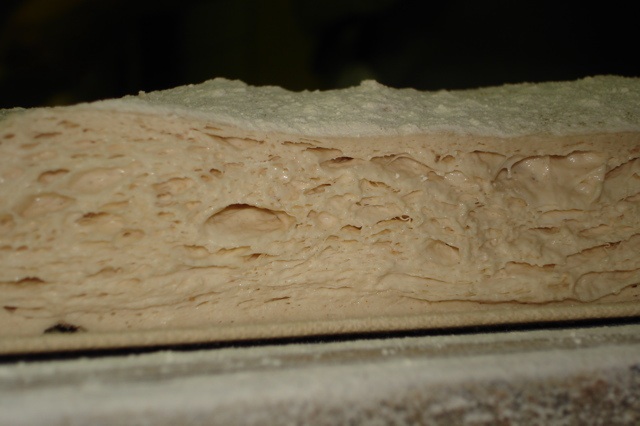 What they do instead, in a technique that could easily be adapted to home baking, is to raise the dough in large square blocks, about two inches thick before they have their second rise. You can see one of the blocks from the side here - the airiness of the rise is extraordinary, and something I've never managed at home. As Francois's boss said when he came in later to inspect the day's baking (and he does so with care and attention), proper bread has small, medium, and large holes. As you can see from the dough, those have already been formed, and need only the air that comes with the oven to solidify.
What they do instead, in a technique that could easily be adapted to home baking, is to raise the dough in large square blocks, about two inches thick before they have their second rise. You can see one of the blocks from the side here - the airiness of the rise is extraordinary, and something I've never managed at home. As Francois's boss said when he came in later to inspect the day's baking (and he does so with care and attention), proper bread has small, medium, and large holes. As you can see from the dough, those have already been formed, and need only the air that comes with the oven to solidify.
As Francois thinks about what to bake, strips, chunks, or rolls can be cut from the blocks and put into the oven. The result is a rough, country, bread, but the customers know it's quality, and don't worry about how it looks, the way a less knowledgeable crowd might. 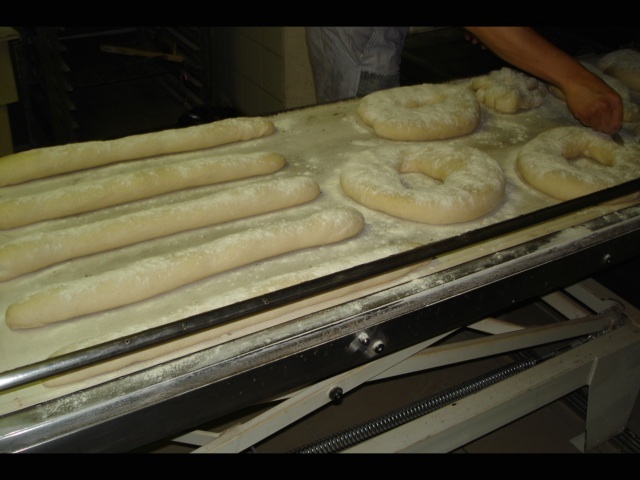 In any case, Francois begins the day by cutting the long baguette-like standard loaves from the dough blocks with practiced slices of a sharp chef's knife. Getting through so much well risen dough without doing it harm is a real skill, it turns out, as I found out when I tried to do it myself later. The result, when done by Francois, and not me, is something like the picture to the left, here - shaped dough ready to slide into the oven on this incredibly clever canvas peel, which goes straight into the oven, leaves the dough inside, and comes out again. (those, by the way, are indeed baguettes - they make a few for the recalcitrants, and my picture of the normal loaves on the peel didn't come out).
In any case, Francois begins the day by cutting the long baguette-like standard loaves from the dough blocks with practiced slices of a sharp chef's knife. Getting through so much well risen dough without doing it harm is a real skill, it turns out, as I found out when I tried to do it myself later. The result, when done by Francois, and not me, is something like the picture to the left, here - shaped dough ready to slide into the oven on this incredibly clever canvas peel, which goes straight into the oven, leaves the dough inside, and comes out again. (those, by the way, are indeed baguettes - they make a few for the recalcitrants, and my picture of the normal loaves on the peel didn't come out).
The bread is hurled into the oven, and then Francois steams the inside to help the crusts rise before they set (if you don't use steam, the crust will set before the bread has risen to its full height). At home, you'd normally do this with ice, but Francois's ovens have a button to push, and suddenly water is pushed loudly into the baking chamber. 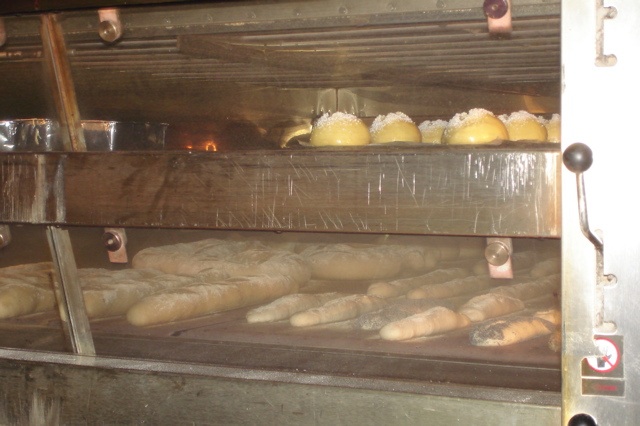 Here is a picture of the bread as it begins to bake, with the steam having just gone in. Notice the brioche baking above, shaped minutes before by Christof while waiting for the levain to get ready. They don't need the steam: between the long baking time of brioche, and its inherent wetness due to the eggs and butter, the crust setting problem isn't quite as severe.
Here is a picture of the bread as it begins to bake, with the steam having just gone in. Notice the brioche baking above, shaped minutes before by Christof while waiting for the levain to get ready. They don't need the steam: between the long baking time of brioche, and its inherent wetness due to the eggs and butter, the crust setting problem isn't quite as severe.
As the first bread goes into the oven, and the steam is injected, Francois's rhythm begins to pick up considerably. While that bread bakes, Francois must get the next loads into the second of the three baking chambers. Otherwise, he'll fall behind - the bakery can only be prepared for the morning rush if all three of the chambers are baking close to full capacity. So he cuts new loaves, and places them on the peel, and in they go as well, followed closely by steam. 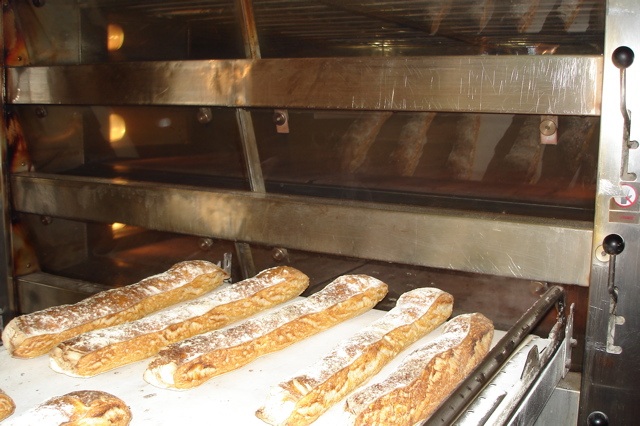 A third set goes into the ovens, and just then, one of the dozens of timers hanging around the bakery goes off, signalling that the first set of bread is done. The bread comes flying out of the ovens on the peel, and suddenly the air is full of crackling, as the bread hits the colder (though never cold - working in front of ovens is hot work) air outside. You can see loaves just out of the oven here to the left. As they come out, the oven floor has to be swabbed with a long brush, in order to get the ashes away from the next installment of bread (which would otherwise give a burned flavor to the loaves), and then Francois rapidly cuts another set of bread from the huge planks of dough. In the meantime, he's flying back and forth to the back, where the croissants are having their final rise, and they're hitting the seperate convection oven as well. And so that's the pace. Bring the dough out - cut the dough - put it onto the peel - - check the croissants- slam into the oven - steam the bread - swab the next oven as timers urgently demand intervention - pile the bread onto the display cases to cool. Like a naval gunner, Francois has to keep up the pace, load, ram, swab, fire, in the sure knowledge that even if he's saved the terror of a cannon ball coming the other way, the customers, the enemy/friends of the baker, are approaching - slowly waking, getting hungry, thinking of breakfast and lunch. And thinking of Francois's bakery.
A third set goes into the ovens, and just then, one of the dozens of timers hanging around the bakery goes off, signalling that the first set of bread is done. The bread comes flying out of the ovens on the peel, and suddenly the air is full of crackling, as the bread hits the colder (though never cold - working in front of ovens is hot work) air outside. You can see loaves just out of the oven here to the left. As they come out, the oven floor has to be swabbed with a long brush, in order to get the ashes away from the next installment of bread (which would otherwise give a burned flavor to the loaves), and then Francois rapidly cuts another set of bread from the huge planks of dough. In the meantime, he's flying back and forth to the back, where the croissants are having their final rise, and they're hitting the seperate convection oven as well. And so that's the pace. Bring the dough out - cut the dough - put it onto the peel - - check the croissants- slam into the oven - steam the bread - swab the next oven as timers urgently demand intervention - pile the bread onto the display cases to cool. Like a naval gunner, Francois has to keep up the pace, load, ram, swab, fire, in the sure knowledge that even if he's saved the terror of a cannon ball coming the other way, the customers, the enemy/friends of the baker, are approaching - slowly waking, getting hungry, thinking of breakfast and lunch. And thinking of Francois's bakery. 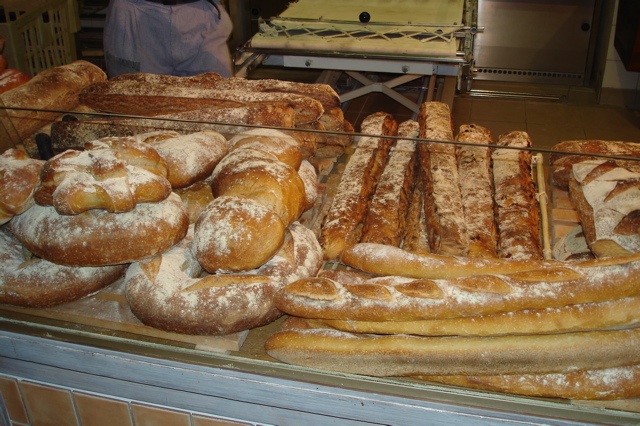 Sometimes, bread has to go back into the ovens to dry out - something that happens especially with the larger loaves. If the bread isn't properly dry, Francois tells me in between thrusts with the peel, the remaining moisture seeps through the crust, and results in bread that goes soft quickly outside the oven. That kind of bread won't sell. And it's a loss for the bakery.
Sometimes, bread has to go back into the ovens to dry out - something that happens especially with the larger loaves. If the bread isn't properly dry, Francois tells me in between thrusts with the peel, the remaining moisture seeps through the crust, and results in bread that goes soft quickly outside the oven. That kind of bread won't sell. And it's a loss for the bakery.
His tireless efforts start to have an effect, as kilograms of bread begin making their way out of the oven. By 6:30, Francois has made an excellent start. As you can see from the picture, a wide variety of breads have been prepared, including normal loaves, loaves with figs, raisins, and nuts, and different shaped loaves prepared with the normal bread. Over to the left, outside the view of the pictures, Francois has got a full range of croissants, brioches, cookies, and other things ready to go. And yet, there's still a half hour to bolster the quantity of breads on offer, and so second iterations of all these things hit the oven, and Francois still has half an hour of flying left to go.
In the meantime, Christof has made incredible progress in the back with the kneading. The levain has gone into the huge mixers (and yes, of course they use mixers. 60 kg of dough doesn't get kneaded for the requisite 15 minutes by hand - 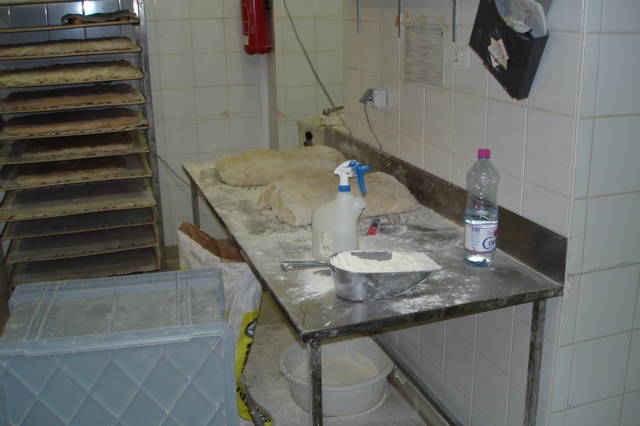 not, at least in modern times, which makes one wonder how earlier bakers managed) with more flour, a little baker's yeast, and water, and the dough has already had one relatively slow proof. Now it's divided to be formed into the planks for the slow, overnight rise, as you can see here. That's also Christof's job, and even if Francois wanted to do it, he's too busy at the front. The whole process of pulling those big packs of dough into the two inch planks is deceptively simple. If requires touch, and dexterity, to bring the dough to the requisite size without crushing the efforts of the first proof, and to make sure the plank is evenly distributed throughout. Thanks to Christof's efforts to humor me, I had a go at it, and did pretty well, I thought. But Christof still had a lot of work to fix my mistakes, and his hands flying underneath the 10 kgs of dough demonstrate exactly what three years of training and five years of experience baking hundreds of leaves every morning do for someone's skill level. I lost track of how many of these planks Christof prepared for the morning, but it was more than I cared to do. And he still had several other doughs to prepare.
not, at least in modern times, which makes one wonder how earlier bakers managed) with more flour, a little baker's yeast, and water, and the dough has already had one relatively slow proof. Now it's divided to be formed into the planks for the slow, overnight rise, as you can see here. That's also Christof's job, and even if Francois wanted to do it, he's too busy at the front. The whole process of pulling those big packs of dough into the two inch planks is deceptively simple. If requires touch, and dexterity, to bring the dough to the requisite size without crushing the efforts of the first proof, and to make sure the plank is evenly distributed throughout. Thanks to Christof's efforts to humor me, I had a go at it, and did pretty well, I thought. But Christof still had a lot of work to fix my mistakes, and his hands flying underneath the 10 kgs of dough demonstrate exactly what three years of training and five years of experience baking hundreds of leaves every morning do for someone's skill level. I lost track of how many of these planks Christof prepared for the morning, but it was more than I cared to do. And he still had several other doughs to prepare.
At ten minutes to seven, the vendeuse (the clerk) arrived, and she got to work arranging the fruits of the morning's labor. As she started arranging the slowly cooling loaves, Francois and Christof (and me, the happy interloper) retired to the back. The two bakers had earned a short break, and they boiled a little water for coffee with breakfast. We had a little debate over whether one could get sick of croissants (the bakers had bread, spread thick with butter. I had (yet another, given what I was doing every other day) pain au chocolat), and we sat, the smell of newly baked bread all around. Soon, Francois would have to swing into action again, as orders for the afternoon came in over the phone, and the French began to eat away at the morning's effort. But in the meantime, and while I watched Francois bake the piecemeal batches that he would the rest of the day (Saturday is different, though, because he needs to stay at full capacity almost the whole day), I observed the second part of the boulanger's craft - the business side. And that side is fascinating when dealing with clients who are as justly demanding as the French. Some ask for bread "bien cuit" - extra crispy. Others ask for slices (the bakery sells bread by the kilogram, so you can get slices of any bread - even as little as 100g of a baguette) from certain parts of the bread and not others. And several (several!) customers even remarked on an incredibly subtle change in the whole meal flour used in one of the loaves, which was changing as the season changed, and newer flour arrived. Francois kept working until one, by which time the owner of the bakery had arrived. He himself would do the baking in the afternoon, in order to keep his hands in the work. But by one o'clock, both Francois and I were in his car again, me clutching several sample loaves for later. We were headed home - and Francois at least to his bed for a siesta.
I went off to my uncle's Persian rug shop to rest, though I wouldn't sleep till the night. And to think about the day. There is no denying that bread baking is a hard job. You're up with the prostitutes, as I had remarked to Francois as we drove through the infamous Bois de Bologne to get to the bakery, and the work is hard work. It's not law firm work, cosseted by dinners and offices and air conditioning. It's hot in the summer, and cold in the winter (bakeries don't have heaters, because they mess with the environment), and in front of the ovens, its hot all the time. Flour is everywhere, even in an immaculate bakery like Francois's, where both bakers do their best to sweep and clean constantly. And at peak times, the work is physically difficult - speed, and strength to lift and move hundreds of pounds of dough around. But it's satisfying work, I think. It's the kind of work where you can feel yourself part of an effort to conserve something that's been done properly for a long time, and where you get to see clients who are usually really happy to buy your product. There must be a lot of satisfaction in those two things, however hard the job is, and I'm glad that people like Francois, and his boss, and Christof, are manning the ramparts for the rest of us.
* Anyone who's interested in the yeast v. levain judicial proceedings is well advised to try to find Madeleine Ferrieres, "Histoires des Peurs Alimentaires", which has a whole chapter on it.
** The King Arthur Bread Book has an excellent description of levain, but the most useful recipe I've ever found for it is in Henri Granier, "Apprendre a fair son Pain au levain naturel", which is good because Granier remembered to add pictures. Without pictures its really hard to figure out what the thing is supposed to look like as it ages and ferments.
Comments (1)TrackBack URL for this entry: http://www.crescatsententia.org/cgi-bin/mt-tb.cgi/3913
Le Petit Cafe
I suppose that when you walk into a cozy and bright French restaurant and see Jacques Pepin sitting at the table closest to the door, you ought to take this as a very good sign of wonderful things to come. There were.
The menu is a price-fixe with a fairly small number of choices (about half a dozen appetizers and entrees each, a salad, dessert), which I assume is the way that a restaurant can serve such a largeish amount of food of that quality for only 43 dollars per person. Some of the best food was on the table before we even ordered-- crusty baguette aux cereales, truffle butter (I exclaimed, "so this is what black truffles were made for!"), wonderfully spicy picholine olives, and a few bits of pickled beet (I said, "the problem with my life is that it doesn't have enough pickled beets in it."). Next came our appetizers-- I had a simple and yummy pate with very strong mustard and sour cornichon; my girlfriend had very lightly poached scallops with some sort of citrus accompanying them. I wondered if she should have gone for the escargot, instead, but in retrospect that would have been a too-overwhelming meal given the entrees to follow.
Then the salad-- thin slices of parmesano reggiano over some fresh arugula in a bit of vinegar. The arugula was spicy, the cheese was deep. I wondered jealously where the restaurant got ingredients that good, but at that point I was too happy to feel jealous for long, and we quickly stopped arguing about the Military Commissions Act of 2006 and went back to joyfully contemplating the food and stealing long glances at Jacques Pepin.
Then the cassoulet (hers) and the pork loin (mine) came. Surprisingly enough, they were even better than everything that had come before. The cassoulet was fairly lean, with slightly toothsome beans under some thick slices of medium-rare duck and a duck sausage ("if that was lean, I'd barely be able to eat a fatty one," my girlfriend exclaimed (this was her first cassoulet)). The pork loin was thick and meaty and wrapped in a bit of very sour pancetta. Some day, I aspire to be able to cook meats like this.
Dessert was last but not least. I was going to get the crispy apple tart with caramel sauce (which turned out to be unexpectedly delicious-- I had forgotten that caramel sauce was once a flavorful concoction of burned sugar rather than brown goop that came out of a squirt bottle) but my girlfriend ordered it first, and it seemed like a terrible waste to pass up the chance to experience more things. I ordered the espresso creme brulee-- normally I shy away from creme brulee almost anywhere because I love it too much, and so few places have both a blowtorch with enough juice and a dessert chef with enough patience and skill to get that thick brulee of sugar on top to just the right thickness without harming the creme below. I should have had faith here-- dark chunks of crispy burned sugar on top of a rich, cool, creme were just what I could have hoped for.
Afterwards, my girlfriend asked me how the delights of Le Petit Cafe compared to those of Paris. After pondering, I said that while this had been better than most of the meals I'd eaten in Paris, there were still a few (L'Avant Gout, I'm thinking of you) that had exceeded it. She gave me a wide-eyed look of shock. "There are better meals than this?"
TrackBack URL for this entry: http://www.crescatsententia.org/cgi-bin/mt-tb.cgi/3912
